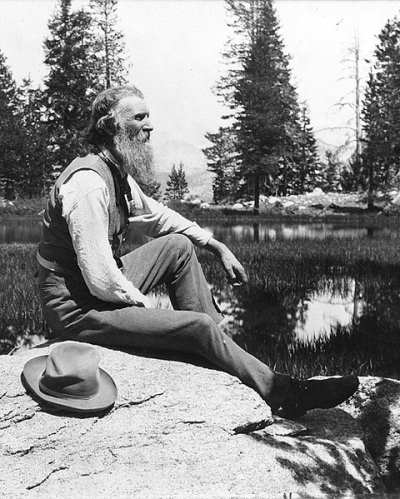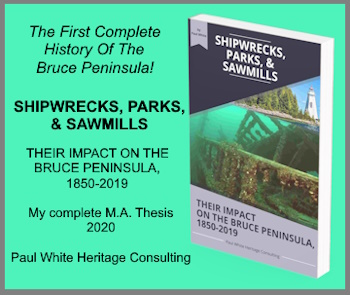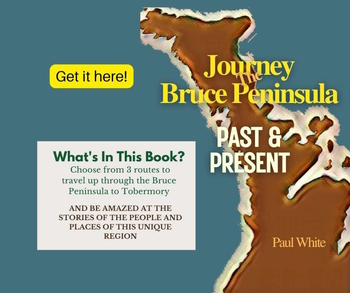John Muir
John Muir, the legendary naturalist, who promoted the idea of protected nature spaces, spent time in Ontario and I went to help find evidence of his stay in the Owen Sound area.
The press release said: “Join the search for what may be John Muir’s teacup.”
Historical research requires a lot of “digging”. I spend hours each week plowing through old newspapers, journals and other information in the quest to find more information about whatever topic I am currently writing about. However, the quest to find John Muir’s teacup requires another form of “digging”!
"Digging" for John Muir's Teacup
A team of archeologists and volunteers are excavating two small sites to find more information about the famed naturalist, John Muir. The focus of the search for artifacts is in a picturesque setting called Trout Hollow on the Big Head River near Meaford.
Muir was a conscientious objector to the American Civil War. He came to Canada and his travels brought him to the Meaford area in 1863. Here he found work at a sawmill operated by the Trout family. He lived in a small cabin on the shores of the Big Head River, a short distance from the mill. His stay in the area was brief. It is suspected that he returned to the United States in 1865.
Local history buffs had known the general location of Muir’s cabin, but it was a stroke of luck that led them to what is believed to be the exact site of his home. In 1998, Robert Burcher, and Connie Bresnahan, a PhD student from Alberta, who was studying Muir’s time in Canada, were participating in a hike sponsored by the Canadian Friends of John Muir to publicize the fact that Muir had lived in the area. When they were passing through Trout Hollow Burcher noticed pottery shards sticking out from the side of a ground hog’s hole.
Later, that day, at a presentation about Muir at the Meaford Opera House, Burcher and Bresnahan showed the shards to Peter Stork of the Royal Ontario Museum. Stork authenticated them as being from the mid-1800s. This led to further exploration in the vicinity of the ground hog’s hole and a nail, spoons and other artifacts were discovered.
A committee was formed to explore the site in more detail. Burcher said that they approached the owner of the land, Ron Knight, and they were pleased to find out that he was very interested in history. In fact, Burcher said that when the head of the committee first met with Knight he was surprised when Knight opened his wallet and pulled out a quote from Muir!
Burcher says that Muir’s time in the Meaford area was probably important in his development as a naturalist. John Muir was a deeply spiritual man and was a member of the Church of Christ. Coincidentally, the Trout family, for whom he worked, were also members of that church. Burcher feels that the combination of the natural beauty of the region, his spirituality, and an industrial accident which he suffered a few months after he left the area may have led Muir to becoming a great proponent of the naturalist movement. Unfortunately, not much remains of Muir’s written recollections of his time in the area. It is believed that his papers were in the mill when it burned down.
The group involved in the dig are members or friends of a group known as the Canadian Friends of John Muir. They are naturalists, amateur historians and archeologists who have come together in the quest to find out more about Muir. Two professional archeologists, Jim Molnar of Lions Head and Jacqueline Fisher of Hamilton, are directing the operations. At first the project was funded by members of the group, but more recently other sources have come forth to finance the dig.
In order to find out more about Muir’s time in the area they have to “dig”. This requires hours of moving earth in the quest for the tiniest artifacts. There are no backhoes or even shovels to move the dirt. Instead the crew uses small trowels and screen sifters. The work is arduous but there is excitement in the air as no one knows what the next scrape of a trowel will reveal!
The pottery shards led Burcher on a personal quest. He spent weeks at museums in Ottawa and Toronto trying to identify the pattern on the shards. Finally, he was able to make an educated guess that it was blue and white earthenware from Staffordshire, England. The design was probably created by Miles Mason who created patterns for several companies from 1800 to 1862. If the bottom of the cup is found it most likely will bear the company stamp of M. Mason; G.M. & C.J. Mason; C.J. Mason & co.; or Ashworth & Bros. The pattern is derived from a drawing of the eruption of Mount Etna in Italy.
The dig will cease on Saturday after another heritage walk through the area takes place. Burcher says that anyone who wishes to join the walk this Saturday should go to the Meaford harbour between 8:30 and 10:00 am. From this point buses will take participants to the starting point of hike. Who knows someone might find the missing pieces to John Muir’s teacup!
For more information about John Muir and his impact on the creation of the National Parks in the United States check out this short trailer about one of my favourite documentaries The National Parks: America's Best Idea by the best documentary maker, Ken Burns,
This Article originally appeared in the Owen Sound Sun Times.
More Grey County Pages
12-year-old Walks to Owen Sound in 1851 from the journal of a teenage boy's experience travelling with his brother in the untamed Upper Canadian wilderness.
1st Grey County Building in 1852 was only built after many hurdles were overcame.
Dr. Anna Henry from Markdale, was a medical trailblazer for women doctors in Canada, who helped lay the groundwork for the establishment for Women's College Hospital.
Egremont Township endured the usual growing pains of a pioneer community, but its early history records times when it was embroiled in a few contentious issues.
Euphrasia Township in the early years when spelling the name was a problem for those who called it home and those that wanted settle this new Grey County township.
Georgian Bay's 1st pioneer settler arrived on the western shoreline long before any other settler reached the area.
Grey County Heritage: A Valuable Resource which is rich and varied, as an important resource for future use for business, political, and many other purposes.
Grey County's Creation in 1852, laid the framework for organizing a county in the last wilderness in the southern region of what would become in the future the province of Ontario.
An Unlikely Hero From Grey County (Part 1) found his way from the farming community of Flesherton to missionary work in the Ottawa Valley, and beyond.
An Unlikely Hero Vs. The KKK (Part 2) Our hero from Grey County took his missionary zeal south of the border and ultimately crossed paths with the infamous KKK!
Barn Raising: A Pioneer Economic and Social Necessity as it provided settlers with an opportunity not only to build a barn, but also build a community.
"Barring Out": A Pioneer School Tradition was a custom which the settlers brought to the new world from England, or Scotland.
Ceylon Ontario: How it Got its Name: It is always interesting how a community got its name, but I doubt any place received its name from a more unique source!
Chatsworth Ontario: First Settlers took advantage of fulfilling the needs of pioneer travellers and built a thriving community in the Upper Canadian wilderness.
Clearing Trees a Daunting Task for Settlers as they worked to fulfill their obligations for their land grant.
Dornoch: or is it Smithville? Originally it was Smithville, then it became Dornoch. But, surprise it is still, in reality Smithville!
First Pioneer in Durham: Archibald Hunter established his family, and a hotel, in what would become the centre of the town of Durham.
Durham Ontario Influenced by the Saugeen River. This river provided a means to create new industries, but especially in the spring it can also pose a menace to the community.
Grey County Bylaws to the 1890s reveal a lot about the financing of local government, especially education in the early days of the region.
John Muir, the legendary naturalist, who promoted the idea of protected nature spaces, spent time in Ontario and I went to help find evidence of his stay in the Owen Sound area.
A Heroic Woman From Grey County who made great changes as a doctor in China in the 1890s and early 1900s.
Jesse James: In Grey County? An interesting question. Did the notorious gangster hide out in Proton Township? We will never know. But it is fun to speculate!
Kilsyth's Train Engine was one for the history books. It brought an evening of joy followed by disappointing news soon after.
The Knight's of Meaford have long history in that Grey County community. Their business forged by early settlers employed many locals and supported the economy.
Leith: Tom Thomson's Birthplace is part of the rich heritage of this community located on the east shore of the Georgian Bay north of Owen Sound.
The Leith Golf Course has provided many families with great memories. The history of this golf course starts, and ends, with the generosity of one family.
Agnes Macphail was a political trailblazer in a part of Ontario that one could hardly expect such radical action for the era in a rural region.
Markdale Ontario: The Beginning: originally known as Glenelg East, but the coming of the railway and the name of owner of the land for the station led to a change of identity.
Meaford's history is one of hardy and entrepreneurial pioneers carving their lives out of the wilderness of what would become Grey County.
Meaford Ontario, first called Peggy's Landing located on the shores of Georgian Bay has a rich history.
Meaford vs Purdytown. Conflict over the name of a new community was not unusual in early Grey County but electing a school trustee was the "hot button" issue in this rivalry.
Pioneer Clergyman: John Neelands was the first to minister to the first settlers' spiritual needs riding on horseback through the wilds of early Grey County.
Pioneer Doctor: Dr. James Smith, a local boy who became a doctor and served his community for his entire life was a testament to Grey County community spirit.
Pioneer Healthcare in Grey and Bruce counties was not administered by doctors, nurses, or pharmacists, no it was the responsibility of the women of the community.
Pioneer Homes in Grey County in the 1840s offered only basic amenities. Homes were basic because clearing the land to earn a living to survive were of paramount importance for those embarking on a new life.
Pioneer Ingenuity created many labour saving devices and methods and quite often helped to create a sense of community.
Pioneer Christmas: A Family Tradition as told to me by may grandparents who experienced Christmas as children in the 1880s and 1890s.
Pioneer Settlement Plans for Grey County began almost two decades before the rest of Grey County was available for settlement.
A pioneer road surveyor's impact on the local history of Grey and Bruce counties could have been dramatic, if it had not been changed by another surveyor.
Pioneer Teachers in Grey and Bruce Counties had a long and arduous task, not to mentions strict and confining job requirements for very little salary.
Plowing Match in Grey County in 1933 the first International Plowing Match held in Grey and Bruce counties and it's success led to more such events in Grey.
Settling Osprey Township: Parts of Osprey were considered too rugged to settle, but today they are prime real estate because of the great view!
Swamp College: Proton Township: this colourfully named institution of education in Grey County has provided many stories to the heritage of the region.
Sydenham Township's First Council undertook the often difficult task of creating a new municipal infrastructure.
The Impact of Snow is not what is Used to be! As snow removal equipment has improved the impact of snow on our lives has reduced significantly from previous eras.
Unique Characters: Nathaniel Herriman lived in Grey County and owned an inn to provide food and and accommodation to early travellers. Each day he performed a unique practice.
Unique Maps: Quilts Guided the Underground Railroad to enable runaway slaves to escape to Canada and freedom from the shackles that enslaved them.
The Women's Institute is a group of rural women that has made a difference to the quality of both urban and rural life in Grey County and across the country.






